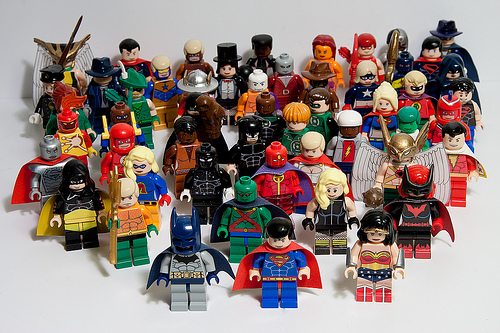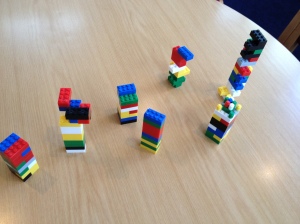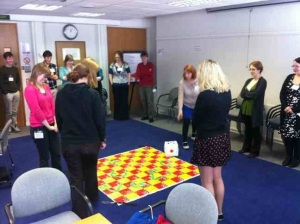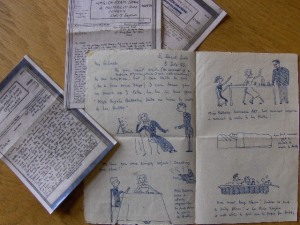Introducing… Cat23 Phase One (An announcement at CIG Conference)
This year’s CIG Conference is entitled “The Value of Cataloguing“, which sounds like a topic right up our street here at HVCats. On Tuesday September 11th, Celine Carty will be speaking at the CIG conference in Sheffield about the new HVCats initiative – phase one of the Cat23 idea. Helen Stein came up with this idea and has been doing amazing work in making it happen, but sadly could not attend CIG to present alongside Celine.
For over a year now, we’ve been pondering the idea of how to make a “23 Things for Cataloguers” work. There are lots of problems doing this kind of professional development programme along the same lines as the traditional library “23 Things”. So, in the end, we’ve taken a slightly different route.
Announcing Cat23
Cat23 will encompass a number of initiatives aimed at supporting continuing professional development for cataloguers and those interested in cataloguing.
We are delighted to introduce phase one: a series of interviews with cataloguing practitioners to find out more about the day-to-day realities of working as a cataloguer. We hope that this will provide a real insight into current cataloguing work and answer some questions about what cataloguing actually involves. The interviews aim to cover a range of type of material, type of library and give some idea of the diversity of cataloguing and metadata work. We hope to provide a rounded view of the practicalities of dealing with a specific typical item and the tools used by cataloguers to deal with problems and answer questions. We hope that the interviews will be of interest both to people who catalogue in their current post and to all the cataloguing-curious. The interviews will be a great way of starting out the cat23 project. Each interview will aim to outline the cataloguing context:
- the types of materials commonly dealt with
- the type of library/institution
- the LMS used
- the specific cataloguing rules & classification system(s) employed to guide practice
- a look at any ‘local conditions’ that influence the cataloguing
- the balance of tasks involved in the cataloguer’s daily work
- the most common difficulties with the type of material being catalogued
- the key help resources for the cataloguer when they come across a problem
To provide an insight into the realities of day-to-day cataloguing, each interview subject will select one item from their current cataloguing to examine in detail as the basis of the interview.
Several interviews have already been carried out, with more to come. Thanks to our generous interviewees in both the UK and the US who have kindly let us in to get a glimpse of their cataloguing work for this project. We hope to post the first of the interviews here on the blog shortly. Watch this space!
Shameless self-promotion
This guest post is by Heather Jardine, talking about the fabulous high visibility initiatives she and her colleagues have implemented for the Bibliographical Services Section of the City of London Libraries. I this these are inspiring ideas, we’d love to hear anything you have to add:
If you are going to do a job at all, you should do it properly. So now that we have decided it is time to promote ourselves and what we do, we have thrown caution to the winds and we are trying almost everything.
We started with tours of the Bib Services Section, what we call “The Journey of the Book”, initially for new staff colleagues but now also for members of the public and for colleagues from other libraries (so now we have three “flavours” of tour – Staff Journey of the Book, Public Journey of the Book and Professional Journey of the Book). The content is essentially the same for all three, but the level of detail varies according to the audience. Fellow professionals always seem most interested in workflow and management issues, members of the public are always fascinated by the processing – all that stickyback plastic takes them back to Blue Peter and their younger days. Yes, it is a faff setting it all up, but we learn as much as our visitors do and almost always people are interested, engaged and persuaded that what we do is valuable and useful, which is enormously satisfying. And, you never know who is going to come through the door on a tour. It might be someone with influence to help us, or someone who will bring us work and income. We all need friends at the moment. We are beginning to think that marketing it as a “behind-the scenes” tour might get more custom – everyone likes to see what goes on out of public view, as the National Trust and many other heritage organisations realised long ago when they started opening kitchens and other below-stairs areas.
One thing leads to another, and because we were doing tours, we decided that we needed a leaflet to hand out both as publicity and as a souvenir in goody-bags.
And we thought that a big, bright, well-designed poster on the wall outside our office would tell people who we were and what we did (it helps that our office is across the lobby from the public toilets, so there are always people about).
After a while, we thought that having a video version of our “Journey of the Book” might bring it to a wider audience, so we made a film and put it up on YouTube. It’s doing OK for views, but we’d probably get more if we had included a skateboarding cat. Oh well, there’s always next time. (That’s one of the things you find out quite quickly – whatever publicity material you produce, you have to review and revise it surprisingly often.)
We have started a blog, too, and made sure that it is picked up by Planet Cataloging, so it gets read as widely as possible.
And we have a page “about” us within our catalogue, and on our Intranet too, of course.
But there is still more to do. Only the other day I was introduced by a colleague as, “This is Heather – she works in the basement”, as if that was the only interesting thing about me. So – what next? My own gut feeling is that Facebook is passé, but we might give it a try nonetheless. Then there is Twitter. I’ve got mixed feelings about Twitter, but I am slowly being persuaded that it can be a useful tool. “Bib Services: the musical”? Probably not.
Perhaps the most important thing to say, is that we started without any special skills or knowledge. We are not marketing professionals, or graphic designers. It’s been a huge learning curve. Maybe when we look back, we think of ways we could have done it better – but there is always next time. Meanwhile, we’ve got something out there. And if we can do it, so can you.
We’d like to hear what you think of what we’ve been doing and to learn from your experience too.
Check out:
The video: An introduction to the Bibliographical Services Section of the City of London Libraries
The blog: Work and expression
About us: The Bibliographical Services Section
Twitter chat on cataloguing & classification from #uklibchat
This guest post is by Joseph Norwood and the rest of the #uklibchat team,and we hope to see a few high visibility cataloguers at the chat on Thursday:
#uklibchat is a fortnightly discussion group for librarians and information professionals, and on Thursday 23rd February between 6:30 PM and 8:30 PM, we’re going to be talking about cataloguing and classification.
An agenda for the chat is available here and can be added to if you have any questions that you would like to raise during the discussion.
These chats are a great way for librarians to share their ideas about a subject and to find out more about things that they may not often come into direct contact with at work. I’m hoping that this discussion will give people outside of cataloguing a chance to learn more about the importance of cataloguing work, and I’m sure it will also be very interesting for people who work or want to work as cataloguers. Topics to be discussed on the day include the future of cataloguing, training, and how catalogues could be presented to users.
More information about the chat; and summaries of previous chats can be found on our blog (http://uklibchat.wordpress.com/).
The #uklibchat team can be contacted by Twitter through @uklibchat if there’s anything you’d like to ask us.
Libday8: the Cataloguers

Here’s a list of people with catalog(u)ing / metadata / systems roles who have signed up for Library Day in the Life Round 8. It’s a rough list, put together from the descriptions people gave on the libday wiki page supplemented by people who contacted us letting us know they were taking part. If you’re involved in something catalog(ue)-related and want to be added here and to our twitterlist, let us know.
- @AhavaCohen (Love in the Library)
- @AnneWelsh (Library Marginalia)
- @Annie_Bob (The Hobbit Hole)
- @archelina (The toast in the machine)
- @bibliosaurusrex (Bibliosaurus Rex: beyond 140 characters)
- @bringyournoise (bringyournoise)
- @ces43 (Librarian in training)
- @cololibrarygirl
- @darklecat (Dark side of the catalogue)
- @evil_jen (Includes bibliographical references and index)
- @Jason_W_Dean (The Dean Files and Jason’s Grey Cells)
- @JohnsanG (Life through a lens)
- @libdespot (245 00 $a Split files : $b a blog)
- @librarianofdoom
- @millieshoes (The Bradford Librarian)
- @sara_mooney (Sara Mooney)
- @sidesmirk
- @slmcdanold (The randomness that is life); also on Google+ and flickr
- @stjerome1st (Blogging cataloguing)
- @ULtower (Discovery)
Image: DC Hero Minifigs (most of them) by Julian Fong. Copyright Commons, some rights reserved.


